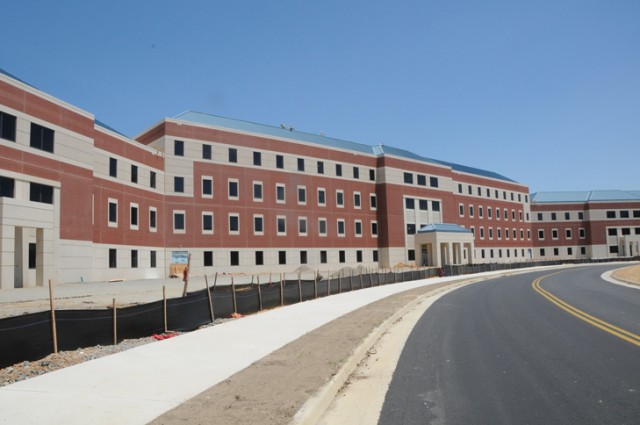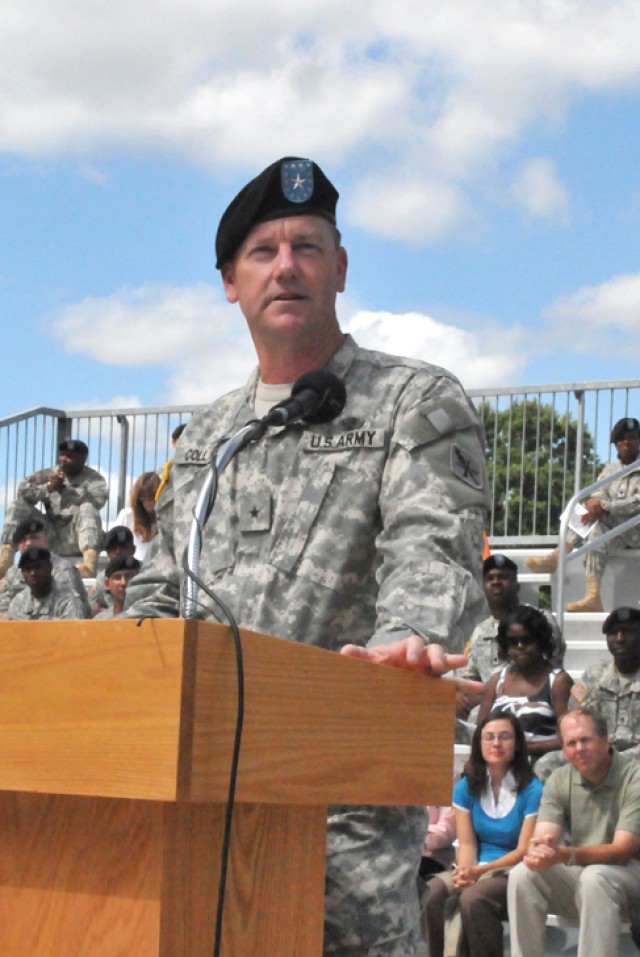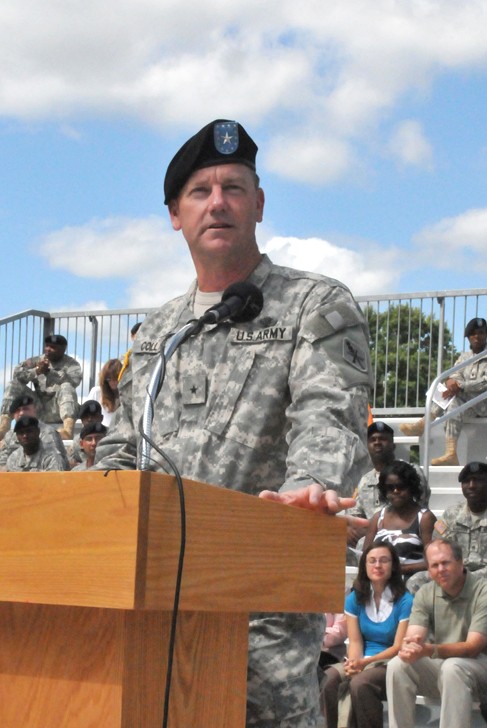FORT LEE, Va. (June 3, 2010) -- It's been a month since Ordnance Week was held here. The event, one that serves to strengthen bonds with its internal and external community, was the first that took place at Fort Lee, the new home of the Ordnance Corps and School.
The turnout wasn't as big as those previously held at Aberdeen Proving Ground, Md., former home of the Corps, yet it was productive and spirited, said Brig. Gen. Lynn Collyar, host of the event and commanding general, Ordnance School.
Collyar, who has presided over the school's complex consolidation and relocation to Fort Lee since the summer of 2008, said the event attracted a mix of active and retired Soldiers and Civilians. It made for some interesting discussion and response, he said.
"When you get all those senior, active and retired guys and gals in one room and go over some briefings on where you are today and where you're headed, you get a lot of feedback, institutional knowledge and things to think about,'' he said.
Two ordnance military occupational specialties closed to women were among the issues discussed. Soldiers trained as Abrams tank and Bradley Fighting Vehicle system maintainers are sometimes part of a team of Army personnel who service combat vehicles on the battlefield. Collyar said it has been difficult to continue the justification for the restriction, considering the non-linearity of modern warfare.
"They're on a maintenance support team where other MOSs on that support team are authorized to be female," said Collyar, "... everybody is at risk."
Collyar said the response to the point of discussion was positive and in concurrence. "I got a lot of good feedback," said Collyar, "and mainly it was that no one could see how we could continue to justify the MOSs being (unavailable) to females."
Recoding the MOSs through the U.S. Army Human Resources Command will be the next step in the process to lift the restrictions. Collyar, however, cautioned that the process isn't as simple as it sounds.
"You also have to make sure that the school that trains Soldiers in those areas has the facilities for females," he said. Collyar anticipates there may be more issues to be worked out, and if approved, the entire process could take some time.
"We'll work through them and next year," he said, "we'll probably start allowing them (females) in."
Aside from the discussions that took place during Ordnance Week, Collyar said he had the honor of showing off the new school. He said the elaborate new campus was a counterpoint to the uncertainty expressed by many regarding the Base Realignment and Closure action that relocated the school.
"For all of the naysayers of BRAC - those who retired at Aberdeen - to get those guys down here to go through the facilities and see how much better things are, was a great opportunity," said Collyar.
The group attended a ribbon-cutting that celebrated phase one of the construction, the completion of three barracks and two headquarters buildings. The last structure completed was barracks No. 3 in February. Each one offers more than 180,000 square-feet of living space. Rooms in the facilities accommodate two Soldiers and feature a private bath. The group toured the structures following the ceremony. Collyar took that opportunity to tout the merits of the move.
"The eyes do a whole lot better than your ears do at telling people to become advocates," said Collyar. "Every one of those people who came here for Ordnance Week and who left from here are now an advocate for why the Ordnance Corps needs to complete this move to Fort Lee and the benefits associated with it. That was the biggest thing we could get out of it."
Some of the other facilities on the campus - the country's largest welding training facility, the largest Army-operated dining facility in the world and the Warrior Training Center - all made for an inspiring experience, said Collyar.
"We won over a lot of people," he said "There were a lot of people who were saying, 'Boy, I wish I had that when I was either going through training or when I was the person providing that training.'"
New facilities aside, Collyar said the Ordnance Corps is enduring a transformation on the training front as well.
"While we are trying to complete the physical move, we're trying to make this a complete transformational move for the Ordnance Corps, changing the way we train and adding into that training more of a skills-based program versus one that is platform-based."
SBT programs emphasize multi-functional skills, said Collyar, in which maintenance Soldiers will be trained to service more than one type of vehicle and developed to be problem solvers.
"Instead of us training a Soldier on a HUMVEE, giving him a practical exercise and testing him on that vehicle, now we will primarily teach him hydraulics, mechanics, optics and electronics," said Collyar.
SBT is a more practical solution to training issues because it emphasizes critical thinking and problem-solving skills, critical to servicing the operational Army's ever-changing vehicle inventory.
"Systems that we don't have in the training base today, like the MRAPs they're maintaining in the Iraq and Afghanistan area of operations, just becomes another wheeled vehicle," said Collyar. "When it rolls in, the maintainer can be confident in himself that he or she can accomplish the maintenance."
Collyar said the SBT program has been implemented in some of the electronics-based and engineer maintenance military occupational specialties.
"For some courses, it will be more of a transformation and for others, it's the next step, an evolving process," said Collyar.
With regards to other issues, Collyar said he is satisfied with the construction progress. When the Ordnance Campus is completed next year, more than 30 new buildings will have been delivered, accommodating 4,000-5,000 cadre and trainees.
Currently there are only about 700 military members training at the campus on an average day. Collyar said.
"Right now, we're a very small percentage of the people physically moved," he said. "That's mainly because of the timing associated with breaks in classes that we had to schedule in order to finish courses at Aberdeen, package up the equipment, have it moved and set up down here to allow the next group of people to come down."
The Ordnance School received the delivery of an M1 Abrams Tank and a Bradley Fighting Vehicle three weeks ago. Collyar said the next large group of Soldiers and equipment will make their way to Fort Lee sometime this month.
"That will put us up to a balance of 1,500 Soldiers a day that will be training here," said Collyar. "That means that we're about a third of the way done with the people moves. The facilities are about halfway complete. I don't foresee any problems with us moving the rest of the Ordnance Corps here (by the summer of next year)."
The Ordnance School will eventually move 85 different courses to Fort Lee and will eventually become the largest tenant on the installation that was formerly dubbed Home of the Quartermasters. Collyar said he is aware of the relationship and bond the post has with the QM Corps and is enthusiastic about working together, especially when it comes to community service.
"We owe it back to the community to provide support," said Collyar. "I think in the long run, all of the surrounding areas of Fort Lee will see the benefits of having more Soldiers here, economically and as well as a positive community presence."




Social Sharing